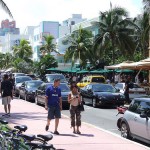- 2 Minute Read
- 08th March 2010
City Guide of Miami
Population & Landmark…
Miami is a major city in the southeast corner of Florida. The city was founded 100 years ago, when a tycoon called Henry Flagler extended his railroad to carry citrus fruits from the frost-free south.
The city’s population growth in recent years has been driven by internal migration from other parts of the country as well as by immigration. Miami is the second-biggest city in Florida, known as the Latin Capital of the US with 409,719 people living in the city centre. Nowadays, Spanish is spoken as pervasively in Miami as English.
Greater Miami is viewed as a cultural melting pot, heavily influenced both by its very significant population of ethnic Latin Americans and Caribbean islanders.
Economy…
 For most of Miami’s history, its economy has been based on tourism. While it is still the principal industry in the city, the economy of Miami has become more diversified with over 170 multinational companies in the city and its environs. Many businesses choose to establish their Latin American headquarters in southern Florida. Miami-Dade County is known as the Gateway to the Americas.
For most of Miami’s history, its economy has been based on tourism. While it is still the principal industry in the city, the economy of Miami has become more diversified with over 170 multinational companies in the city and its environs. Many businesses choose to establish their Latin American headquarters in southern Florida. Miami-Dade County is known as the Gateway to the Americas.
The top economic sectors include tourism, services, trade, manufacturing, real estate and construction. It is a major center of commerce, finances, corporate headquarters, and boasts a strong international business community. Miami’s access to Latin America has made it a top international banking and investment center, with most bank offices located in the city’s financial district along Brickell Avenue.
Today, it is home to the international trade divisions of a number of major U.S banks. The city’s financial institutions have won important business in connection with economic development and privatization in Latin America countries. Miami is one of the country’s most important financial centers.
Office Rental Levels…
 As per Grubb & Ellis Market report for the second quarter of 2008, the vacancy rate increased 60 basis points to 10.7 %. Negative net absorption in both the CBD and suburban submarkets along with recent construction completions contributed to the market’s quarterly vacancy increase.
As per Grubb & Ellis Market report for the second quarter of 2008, the vacancy rate increased 60 basis points to 10.7 %. Negative net absorption in both the CBD and suburban submarkets along with recent construction completions contributed to the market’s quarterly vacancy increase.
Nearly 800,000 square feet of new office space is due to be delivered this year. Right now there seems to be a real increase in office space availability as the fragile US economy causes more and more businesses to rethink there strategies on capital expenditure. This is putting pressure on landlords to drop asking rents in order to fill the expanding vacant space.
Not so good for landlords but there is good news for all the tenants. As the office market sees a decrease of the demand and an increase of supply, tenants looking to cut business expenses by getting into lower-cost space have an opportunity for a great deal.
Tourism, Attractiveness of the city…
 Tourism is an important industry in Miami. The beaches, conventions, festivals and events draw over 12 million visitors annually from across the country and around the world, spending $17.1 billion.
Tourism is an important industry in Miami. The beaches, conventions, festivals and events draw over 12 million visitors annually from across the country and around the world, spending $17.1 billion.
Downtown Miami is the metropolis nerve centre, distinguished by its sleek skyscrapers, impressive government buildings and cultural centres, and edged by the Port of Miami, the largest cruise ship port in the world.
Brickell Avenue is home to major international banks and businesses, as well as Brickell Village, the area around SW Sixth Street is the place to find all trendy restaurants and nightspots.
Useful Links:
Miami City Guide: www.cityguide.travel-guides.com
Chamber of Commerce: www.greatermiami.com
